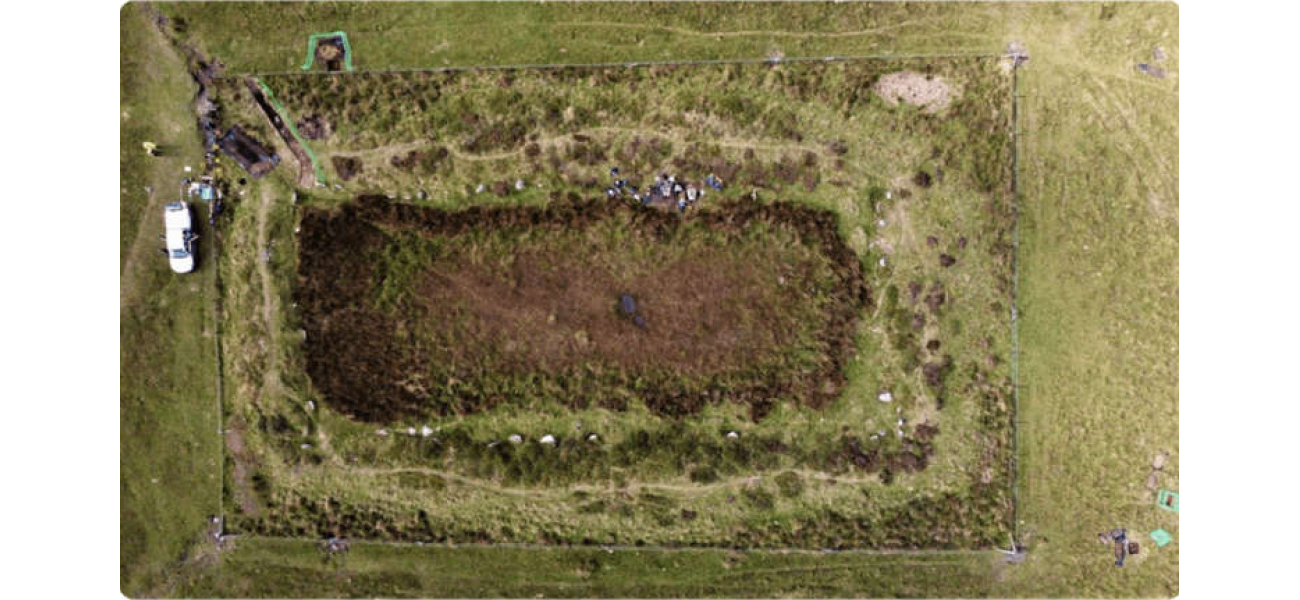Archaeologists find groundbreaking evidence linked to King Arthur, dating back 4,000 years.
Bodmin Moor's perception is altered.
November 13th 2024.

The site on Bodmin Moor in Cornwall has long been associated with the legendary King Arthur, but new evidence suggests that it may be much older than previously believed. Excitement is building among archaeologists as they hope to finally uncover the truth behind the myth of King Arthur. The monument, known as King Arthur's Hall, has been dated back to the Neolithic period, a whopping 5,500 years ago, by a team of researchers from the University of St Andrews.
Lead researcher Dr. Tim Kinnaird describes this discovery as a "major revelation," emphasizing the impact it will have on our understanding of the prehistoric landscape of Bodmin Moor. The site, consisting of a rectangular bank of earth and stone and 56 standing stones, was previously thought to be a medieval animal pen from around 1000 AD. However, with this new evidence, archaeologists now have to reevaluate their understanding of Bodmin Moor.
The site's standing stones have long been a source of speculation about its age, and now it seems that this speculation was correct. Dr. Kinnaird explains, "It's extremely exciting that we've finally been able to date construction of this enigmatic monument, previously grounded in myths and legends." The site, protected by Historic England, was initially thought to be much younger, but with the use of a technique called optically stimulated luminescence (OSL), the team was able to accurately date it back to the Neolithic period.
King Arthur, the legendary British king, has been a source of fascination for centuries. Although there is little evidence to suggest that he actually existed, he remains a prominent figure in medieval literature. Some scholars believe that the myth of King Arthur may have been based on a high ranking military general in the Roman army. However, through a mixture of Welsh, English, and French literature, the figure of King Arthur evolved into the legend we know today.
The excavation of King Arthur's Hall was commissioned by Cornwall National Landscape, after initial investigations by a group of local amateurs raised questions about its medieval attribution. The team of researchers, joined by volunteers, began their dig in 2022. Samples taken from the monument, including pollen, insects, and parasite eggs, were radiocarbon dated and confirmed to be from the Neolithic period.
The middle Neolithic was a time when people were beginning to settle in one place and build enclosures. This suggests that the site may have served as a community gathering point or a place for special occasions. Lead archaeologist James Gossip explains that the site is unique, with no parallel in Europe. Its rectangular shape and arrangement of stones make it one of a kind.
The name "King Arthur" has been associated with the site since at least 1583, but what makes this discovery even more intriguing is that there is no other site like it in Europe. The mystery surrounding the purpose of King Arthur's Hall adds to its enigmatic nature. With this breakthrough in dating, we may be one step closer to unraveling the legend of King Arthur and understanding the significance of this ancient site on Bodmin Moor.
Lead researcher Dr. Tim Kinnaird describes this discovery as a "major revelation," emphasizing the impact it will have on our understanding of the prehistoric landscape of Bodmin Moor. The site, consisting of a rectangular bank of earth and stone and 56 standing stones, was previously thought to be a medieval animal pen from around 1000 AD. However, with this new evidence, archaeologists now have to reevaluate their understanding of Bodmin Moor.
The site's standing stones have long been a source of speculation about its age, and now it seems that this speculation was correct. Dr. Kinnaird explains, "It's extremely exciting that we've finally been able to date construction of this enigmatic monument, previously grounded in myths and legends." The site, protected by Historic England, was initially thought to be much younger, but with the use of a technique called optically stimulated luminescence (OSL), the team was able to accurately date it back to the Neolithic period.
King Arthur, the legendary British king, has been a source of fascination for centuries. Although there is little evidence to suggest that he actually existed, he remains a prominent figure in medieval literature. Some scholars believe that the myth of King Arthur may have been based on a high ranking military general in the Roman army. However, through a mixture of Welsh, English, and French literature, the figure of King Arthur evolved into the legend we know today.
The excavation of King Arthur's Hall was commissioned by Cornwall National Landscape, after initial investigations by a group of local amateurs raised questions about its medieval attribution. The team of researchers, joined by volunteers, began their dig in 2022. Samples taken from the monument, including pollen, insects, and parasite eggs, were radiocarbon dated and confirmed to be from the Neolithic period.
The middle Neolithic was a time when people were beginning to settle in one place and build enclosures. This suggests that the site may have served as a community gathering point or a place for special occasions. Lead archaeologist James Gossip explains that the site is unique, with no parallel in Europe. Its rectangular shape and arrangement of stones make it one of a kind.
The name "King Arthur" has been associated with the site since at least 1583, but what makes this discovery even more intriguing is that there is no other site like it in Europe. The mystery surrounding the purpose of King Arthur's Hall adds to its enigmatic nature. With this breakthrough in dating, we may be one step closer to unraveling the legend of King Arthur and understanding the significance of this ancient site on Bodmin Moor.
[This article has been trending online recently and has been generated with AI. Your feed is customized.]
[Generative AI is experimental.]
0
0
Submit Comment





